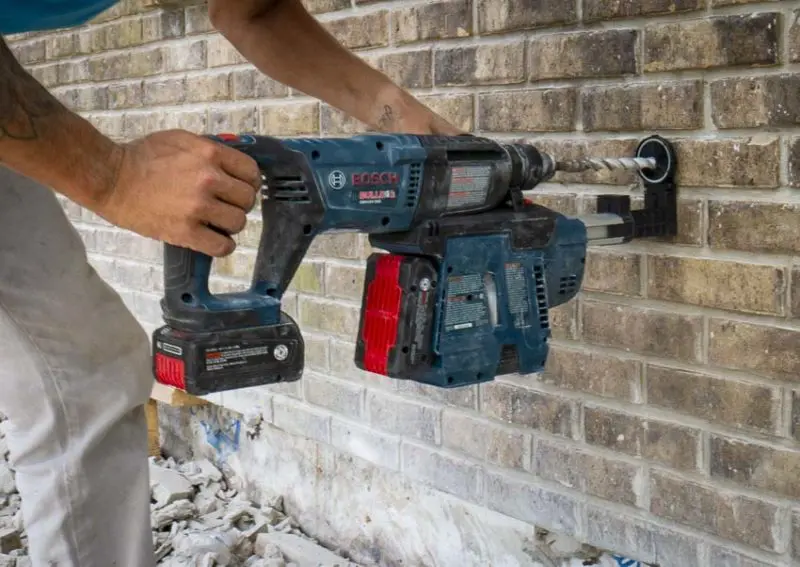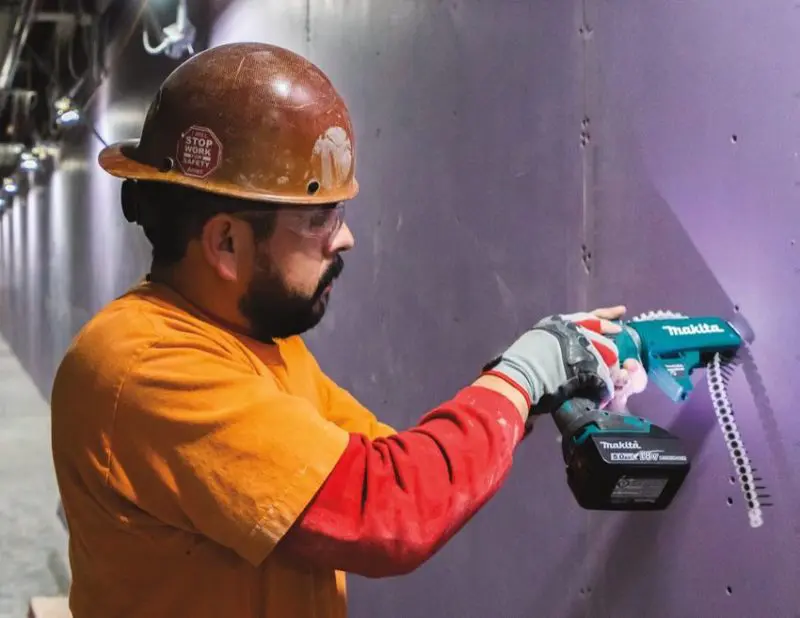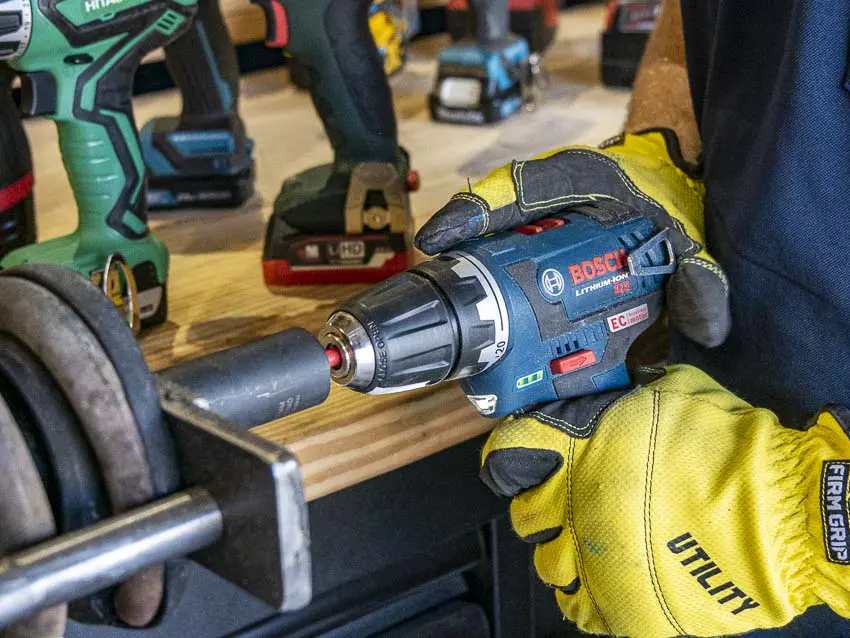Knowing the Different Types of Drills Helps You Pick the Right Tool for the Job
In its simplest form, a drill is a tool that uses rotation or a chipping motion to make a hole. That’s a wide-open definition and includes everything from dental drills to tunnel boring machines. We’re going to focus on the types of drills we commonly use in construction and around the house.
Before we get too far into it, though, let’s get a couple of technical definitions straight. A drill makes holes using a drill bit. A driver fastens screws, bolts, and other fasteners using a driver bit. Most people think of both types of applications when considering a drill. So for our purposes, we’re going to group them together.
Drill Driver – One of the Most Common Types of Drills
Both corded and cordless drills have a chuck that opens and closes around a bit. No matter the voltage, battery size, or brand, these tools simply spin a bit clockwise and counterclockwise. Some cordless drills and drivers also feature a drill clutch that lets you mechanically set the amount of power it transfers when you’re driving screws.

When to Use a Cordless Drill
Use a drill driver for basic hole drilling in plastic, wood, and metal. The size of the hole you’re drilling determines how powerful a drill driver you need. The manual has specifications in it that tell you what sizes it can handle. You can also glean some info from the size of the chuck. A 3/8-inch chuck doesn’t support larger 1/2-inch bits.
Cordless drills also work really well for driving fasteners in plastic, wood, metal, concrete, and just about anything else, though some may require you to drill a pilot hole first.
Hammer Drills
A hammer drill, or hammer drill driver, has the same basic design as a drill. It just adds a hammer mechanism that vibrates the bit back and forth to chip away at concrete. This occurs while the motor spins the bit. Most hammer drills let you select hammer-drilling mode, drilling-only mode, or driving with the clutch. In other words, you can disable the hammering mechanism and use it just like any other drill driver.

When to Use a Hammer Drill
Hammer drills are the do-everything tools of the drill world. Use it for drilling and driving in plastic, wood, metal, and concrete/masonry. Just be aware that most hammer drills are rated up to 1/4″ max for concrete drilling. You may also want a vacuum and shroud to keep from inhaling silica dust and avoid silicosis.
Rotary Hammer (Combination Hammer)
A rotary hammer, or combination hammer (combihammer), is the hammer drill’s big brother. These types of concrete drills range in size from a little larger to much larger than a hammer drill. These use a more robust hammering/chipping mechanism to deliver far greater power than a hammer drill.
These tools usually come with at least 2 modes: chipping and hammering with rotation. Some give you the option of rotation only, but few Pros use it, even though it’s capable of drilling through wood and metal.

Chipping does exactly what it sounds like—it uses a chipping bit to pound like a mini jackhammer for demolition. Hammering with rotation is the mode you use to drill a hole in concrete, asphalt, brick, stone, or other masonry.
When to Use a Rotary Hammer
Use a rotary hammer when drilling holes or breaking up concrete, asphalt, stone, brick, or masonry. The largest of these tools support drilling holes of up to 2-inches.
Impact Driver (Hear Us Out!)
While it’s not really a type of drill, the impact driver makes our list mostly due to the number of hex accessories available. Called an impact driver, the hex chucks on these tools support compatible spade bits, twist bits, and more. Instead of using a forward chipping mechanism, impact drivers use a rotating hammer and anvil mechanism. As the chuck turns, the hammer violently strikes the anvil, giving it a much greater turning force than a standard drill.
As we alluded to above, many drill bits now come with “impact ready” 1/4-inch hex shanks. This lets you drill holes in metal, plastic, or wood with your impact driver. It’s not as smooth as a drill, but it certainly gets the job done.

When to Use an Impact Driver
Impact drivers are the screwdriving champions of the construction world, driving screws faster than a standard drill driver. While you can use it to drill holes with the right bit, many Pros use it alongside a drill so they don’t have to switch bits while they work. When deciding between a drill vs an impact driver—use both. It can really save you some time.
Core Drill
A core drill is one of the more rare types of drill. It’s basically a large motor, sometimes attached to a frame that holds it steady while it drills. It turns a core bit—a cylindrical bit that creates a core to remove instead of grinding out the entire hole. All it does is spin the bit. There are no hammering, chipping, or driving applications.

When to Use a Core Drill
Nothing does the job of a core drill. Turn to a core drill when you need to make large holes in concrete—even up to several feet in diameter! These specialized tools move slowly, but sometimes the work simply takes time.
Ground Auger (Earth Auger)
A ground auger, or earth auger, uses either AC or gas power to turn its powerful motor. Augers use an aggressive, wide type of drill bit that tears through the ground and removes dirt faster and easier than a post hole digger or shovel. More recently we see cordless augers like the Makita earth auger and the Ryobi 40V brushless auger hitting the scene. These bring cordless convenience and battery power to a tool that had previously been limited to gas.

When to Use an Earth Auger
Earth augers function as large ground-moving machines. These types of drills make your life easier when you need to make a hole in the ground (or even ice). Use it for setting posts of all types and when cutting a hole for ice fishing.
Be aware that, while earth and ice augers look and function similarly, you do see some differences. An ice auger typically spins at higher RPMs, for example. These tools also don’t weigh as much as earth augers, and the sharp blades don’t tend to bind up, so they rarely include a clutch. Lastly, the less steep blade pitch and sharper blades of an ice auger make it better-suited for digging into ice as opposed to navigating rocks and dirt.
Cordless Screwdriver
While not technically a drill, powered screwdrivers work in the same manner as a drill. These usually have an inline design instead of a pistol grip and have lower power than a standard drill driver. They spin the chuck clockwise or counterclockwise and are primarily useful for driving small screws. While they are capable of drilling small holes, they’re not the best tool for that job.

When to Use a Cordless Screwdriver
Powered screwdrivers are best on small and/or delicate fasteners that don’t require the torque of a standard drill driver. They’re great for working in electrical boxes, setting switch plates, and anywhere else you could use a handheld screwdriver.
Drywall Screwdriver (Drywall Screwgun)
Drywall screwdrivers are also not technically drills and are purely a driving/fastening tool. These often spin at higher RPMs to quickly set screws. While sharing the basic design of a pistol grip drill, these sometimes have a grip directly behind the motor and a lock on to let you work faster. Professional models often have collated magazines that let you automatically feed screws as you go. This speeds up the job tremendously.

When to Use a Drywall Screwdriver
The name says it all, drywall screwguns help you quickly install drywall sheets. Models that can handle longer screws also make deck-building a breeze.
Wrapping It Up
Did we miss any other types of drills out there? No matter what job or project you have lined up, they all trace their roots back to when humans first learned how to rotate a pointed stone back and forth to make a hole in another object. When you look back even 100 years, it’s amazing how far drills have come!



